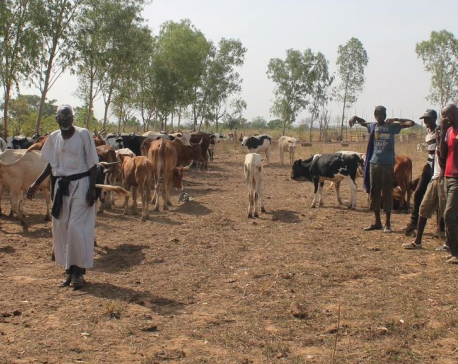
OR

The Social Welfare Council of Nepal listed over two hundred INGOs working in Nepal in the fiscal year 2072/073. Although these organizations have wide-ranging interventions, most engage in some form of dealing with gender based violence (GBV) with a specific focus on women as the victims.
As a group that has been the recipient of many injustices, this intense and increased focus on women is understandable. However, an important area for work that needs to be scaled up includes working with men and boys, not as perpetrators of violence but as victims themselves. There needs to be attention on the less-told story, which is that a striking number of men are victims of both physical and mental violence.
Men around the globe face GBV on a daily basis. The data from Home Office statistical bulletins and the British Crime Survey reports that assaults on men represent more than 40% of domestic violence in the UK. The National Intimate Partner and Sexual Violence Survey of the USA in 2010 revealed that one in four adult men in the United States will become a victim of domestic violence during his lifetime. The same study found that 8.4% of Asian or Pacific Islander men reported experiencing physical violence by an intimate partner sometime during their lifetime.
Although there is no concrete data on the percentage of men victims of violence in Nepal, independent studies with adolescent boys studying in schools within the Kathmandu Valley have shown boys reporting cases of violence – being touched in ways that have made them feel uncomfortable, and being forced to engage in physical contact without their consent by other men or by women have been cited as some of the more common problems faced by the boys.
Men victims face the same ordeals as any other victim of GBV. Where cases of violence on men have been reported, research has revealed that men fear that their abusers will seek retribution if they report the case. Furthermore, research also demonstrates that the fact that most men do not see the laws and the system as adequately supporting them should they muster the courage to seek help prevents them from ever owning up to the problem. This perpetuates a culture of silence that so often seems to work in favor of all perpetrators of violence.
The biggest fear then is that we may be subconsciously fostering an environment for reverse discrimination. Although our aggressive engagement with solely one sex may not manifest the problems of leaving the other behind in the immediate future, there are concerns that they may begin to appear as we advance. In my personal experience as a woman development practitioner, I find that there are numerous questions that come from the men and boys about why it is that we choose to engage exclusively with girls and women. In communities that comprise of the rural poor population, we need to have clear strategies about how we are going to deal with the repercussions of our actions.
At certain points, if we are talking about gender based violence being exclusive to women and paint a picture, however fragmented, of men as the main perpetrators we are giving out the message that men perhaps cannot be victims of violence themselves. We, therefore, need to have a safety net for managing the unintended consequences of our work.
What further aggravates the issue is the fact that patriarchy and masculinity are such entrenched concepts in most societies over the world that men seldom speak out about the issue in fear of the ensuing shame. Most of the cases never get reported for fear of the stigma attached and therefore it is difficult to get an accurate picture of the data of men affected by some form of violence in their lives.
Moreover, our narrow lens with which we choose to understand violence further curtails us from understanding the bigger picture – that violence is perhaps not a sex-based crime. We need to understand it solely in terms of victims and perpetrators without putting a gendered analysis on it. The socially construed definition of “manhood” in turn hinders men and boys from accessing any services that may be available to them.
As we move ahead, we need to ensure that there is a policy focus on this issue. To complement this, we also need to ensure that we are more socially accepting of the concept of men as victims of violence. It is imperative that our academic circles and policy address this gap to give us an accurate reality so that we can better deal with this issue. Civil Society Organizations can also help create safe spaces for anyone, regardless of their sex or gender, to come in and report their cases without the fear of stigmatization.
A collaborative effort with law enforcement mechanisms to address this can go a long way in providing the safe space that is necessary. At the household level, we can teach our girls and boys about violence and the ways to stand up to it and speak out against it. If we adopt a broad framework to understanding this issue, perhaps we will be able to save the numerous men and boys who have been and will be subjected to violence.
Basnyat holds an MSc from the University of Oxford and can be reached at basnyat.ayushma@gmail.com.
You May Like This

Gunmen kill at least 134 Fulani herders in central Mali's worst violence yet
BAMAKO, March 24: Gunmen killed at least 134 Fulani herders in central Mali on Saturday, a local mayor said, the... Read More...

Third sex should be provided citizenship based on gender orientation: Chaudhary
SINDHULI, April 10: The Blue Diamond Society (B DS), an umbrella organization of the LGBTs, has claimed that there are... Read More...

Violence against women in a month: 170
KATHMANDU, Sept 28: A total of 170 cases of violence against women occurred in the country in a month. ... Read More...







Just In
- NRB to provide collateral-free loans to foreign employment seekers
- NEB to publish Grade 12 results next week
- Body handover begins; Relatives remain dissatisfied with insurance, compensation amount
- NC defers its plan to join Koshi govt
- NRB to review microfinance loan interest rate
- 134 dead in floods and landslides since onset of monsoon this year
- Mahakali Irrigation Project sees only 22 percent physical progress in 18 years
- Singapore now holds world's most powerful passport; Nepal stays at 98th











Leave A Comment